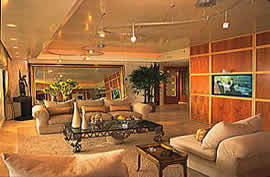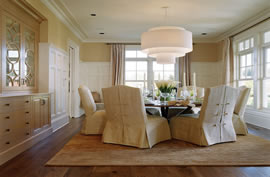Residential Designs
 Whether you’re building a new home or remodeling a single room, you want the finished space to be attractive, comfortable and functional. It needs to fit the way you live, as well as reflect your personal style and taste. Whether you’re building a new home or remodeling a single room, you want the finished space to be attractive, comfortable and functional. It needs to fit the way you live, as well as reflect your personal style and taste.
Interior design addresses all these concerns and more. Images of beautifully appointed and arranged rooms are usually what first come to mind when one thinks of interior design. Color, fabric, furniture, art and ornamentation are indeed important elements in the overall design. How the environments we inhabit look and feel greatly affect our mood and sense of well-being.
 But interior design also involves many practical and technical considerations that affect comfort, function and safety. Among these are lighting, acoustics, space planning, organization and storage, scale, accommodation of special needs, fire safety and compliance with local building codes. But interior design also involves many practical and technical considerations that affect comfort, function and safety. Among these are lighting, acoustics, space planning, organization and storage, scale, accommodation of special needs, fire safety and compliance with local building codes.
Interior projects include new construction, renovation, historic restoration and model homes. Specialty areas within the home include the kitchen, bath, home theater, home office and home health care and fitness areas.
Professional interior designers can do so much more than recommend furniture, fabrics and colors. They have a creative eye and artistic flair, but that’s only the beginning. An interior designer has aesthetic, practical and technical expertise in all the elements that make up an interior environment. He or she understands how people use and respond to these elements, not just individually but as the elements interact with one another. Any number of services and suppliers can provide and install items for the home. Some offer advice on selecting colors, patterns and materials or on arranging the furniture and accessories in a room.
When you hire an interior designer, you get the benefit of an experienced professional who can solve problems, help you avoid costly mistakes and, most importantly, create an attractive, affordable space designed specifically to meet your lifestyle needs.
|

